Psoriasis is a chronic skin condition that cannot be completely cured. The disease requires symptomatic therapy to reduce the severity of manifestations and improve well-being. Psoriasis on the hands is a common localization of pathology. It starts with the appearance of small plaques and can progress without proper treatment.
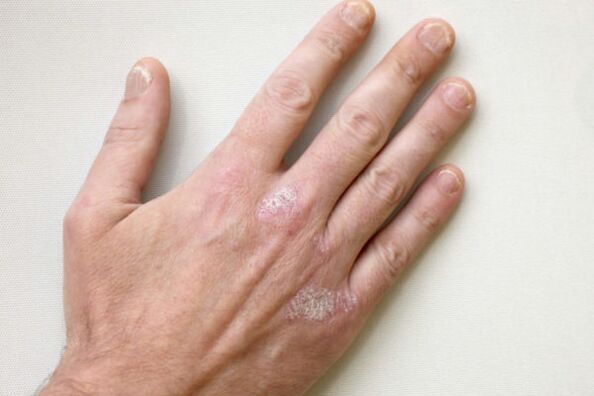
Causes and mechanism of development
Psoriatic plaques on the hands, especially on the fingers, significantly affect the quality of life. Despite the fact that the disease is not contagious, the strange skin defects are alarming. Psoriasis is not the most pleasurable disease, and not only because it seems, but also because of the risk of complications.
The exact etiology of the occurrence of this dermatological disease has not been clarified. Experts identify risk factors that may influence the development of pathology. It is known that psoriasis is not transmitted by contact, it can not be infected by contact with the patient.
It is also important that it is not completely cured, therefore, throughout life, a person is forced to take supportive agents and carefully monitor the condition of the skin at different times of the year. Frequent exacerbations occur in spring and winter. Scientists include the following factors in the development of the disease:
- genetic predisposition;
- lack of immunity, a decrease in the body's protective function;
- frequent skin lesions of viral, fungal, bacterial origin;
- a sharp change in climatic conditions;
- chronic skin diseases, including congenital anomalies;
- long-term use of certain medications, in particular, anticonvulsants, antidepressants, and steroid hormones;
- psycho-emotional overload;
- metabolic disorders in the body.
Psoriatic plaques on the hands begin to appear in the area of small joints, between the fingers, near the phalanges. Pathological elements are most visible on the surface of the palms. It is most difficult to treat psoriasis of such a localization because the hands are often in contact with household chemicals and other irritants.
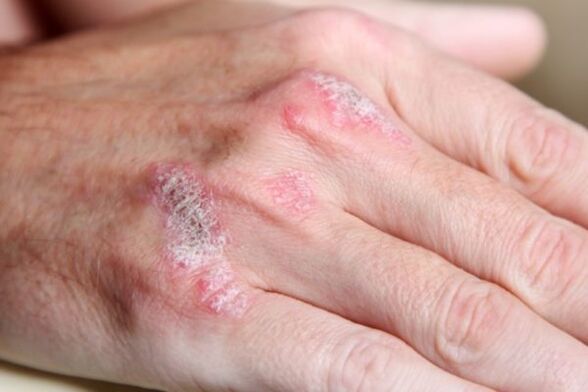
Risk group
The risk group for developing the disease includes men and women who often face other dermatological diseases. The chance of getting the disease increases when there have already been cases of psoriasis in the family.
The pathology can occur in people with weakened immunity, in those who live in unsatisfactory living conditions. The risk group also includes those who, due to their activities, are forced to come into contact with aggressive chemicals.
Clinical manifestations
The first signs in the initial stage of the disease will be the only pathological elements in the hand area. Plaques may appear on the hands, fingers, behind the palms. If the nails are involved in the pathological process, there is a risk of loss of sensitivity and the appearance of tissue edema.
Increased dryness of the skin causes cracks in the palms. There are signs of thickening of the epidermis, which resembles calluses.
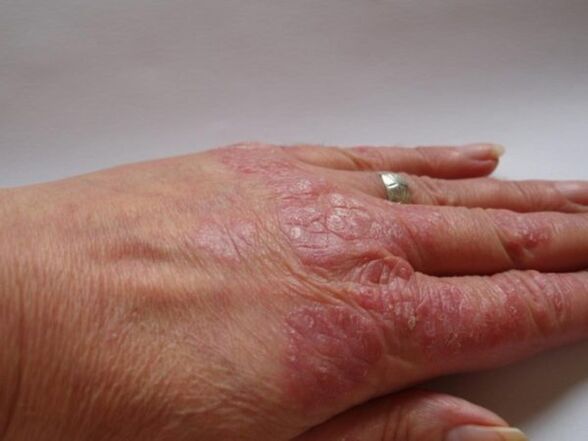
The main manifestations of psoriasis on the hands will be:
- increased dryness, pronounced redness of the skin;
- thickening of the epidermis, an increase in the volume of the fingers due to edema;
- Cracks when cracking tiles
- sometimes there is a combination of several elements with damage to healthy skin.
In winter and autumn, when cold days prevail, the disease appears as intense skin rash. Without treatment, there is the possibility of scratching the infected hands, then the symptoms are supplemented with signs of inflammation.
Forms of pathology
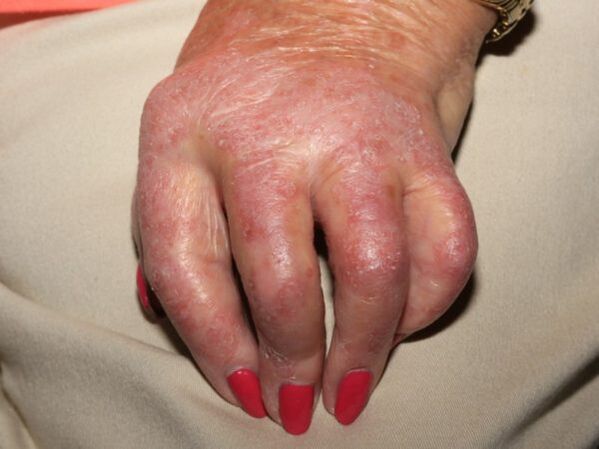
Psoriasis on the hands can take several forms:
- On the fingers. It is manifested by the skin, the formation of plaques, which are often inflamed. Worsening occurs in winter. It often leads to complications.
- On the brushes. Occurs in 25% of patients, the signs are similar to psoriasis on the fingers, while the skin in the affected area becomes rough, redness areas appear. The patient complains of constant discomfort, active skin, itching.
- Palmar-plantar. Occurs in people who are engaged in heavy physical work. The heels and palms are affected. Areas of rough skin resemble solid calluses and very often cracks appear.
- Arthropathic. Psoriasis appears against the background of joint damage. The redness elements are located in the phalanges. In addition to external manifestations, the patient is concerned about joint pain during movement, and then at rest.
- Pustular. Palms and soles are affected. Stress and hormonal pathologies become risk factors. The rash has clear borders and pustules appear. The disease is often recurrent and difficult to treat.
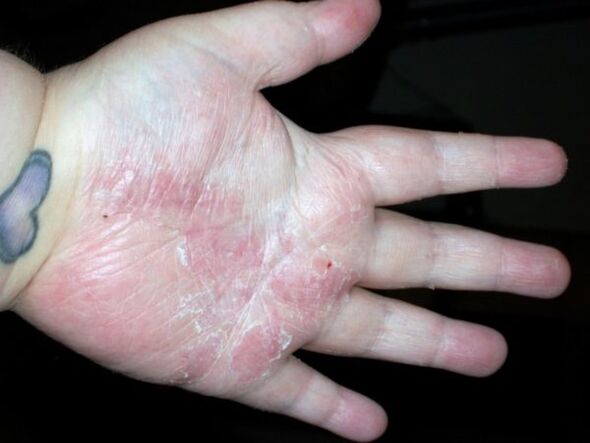
Each form of the disease continues in three successive stages - initial, progressive and stationary. After one cycle (going through 3 stages), the regression of the disease begins. At this stage, the clinical signs almost completely disappear. Treatment aims to prolong the regressive phase as much as possible, otherwise the disease cycle repeats itself constantly.
Differential diagnosis
Psoriasis on the hands is differentiated with pathologies such as lichen planus, Reiter's disease, syphilis, seborrheic and atopic dermatitis.
The distinguishing sign of psoriasis during the examination will be the psoriatic triad, from the presence of which the doctor can diagnose. It includes the phenomena of stearin stain, broken bleeding and terminal film.
Treatment methods
Although psoriasis cannot be completely eliminated, it should be treated to avoid complications and improve quality of life.
The main measures for the treatment of psoriasis on the hands:
- use of care products to hydrate and soften the skin;
- taking antihistamines to relieve itching;
- taking medications to boost immunity;
- additional use of homeopathic remedies.
For psoriatic lesions, physiotherapy and photochemotherapy may be prescribed. When psoriasis is associated with joint disease, pain relievers from the group of non-steroidal anti-inflammatory drugs are used.
Depending on the stage of the disease, the dermatologist will prescribe local anti-inflammatory medications. May be salicylic ointment, ichthyol, sulfur-tar. Hormonal ointments may be used to relieve the symptoms of severe itching; they cannot be used without a doctor's permission.
To soothe and hydrate, you can use baby creams for sensitive skin, which contain herbal ingredients.
Preventive measures
General preventive measures to prevent worsening of psoriasis on the hands:
- use of rubber gloves when cleaning the house when you need to contact detergents and cleaning agents;
- rejection of bad habits, good sleep and balanced diet;
- daily care of the skin of the hands using natural cosmetics or pharmaceutical preparations;
- regular sunlight, frequent ventilation in the house, walking in the fresh air, avoiding stress;
- treating the skin with an antiseptic in case of accidental injury (while bandaging the wound for a long time is not recommended);
- adherence to the Pegano diet, which includes restricting meat dishes, sweets and adding more grains, vegetables and herbs to the diet.
Prediction of the disease
Unpleasant psoriatic rash on the hands is causing stress for many sufferers. At the same time, the experiences only make the situation worse. Psoriasis can be in regression for a long time, but for this you need to follow the therapeutic and preventive measures prescribed by the doctor.
Psoriasis It is impossible to completely get rid of psoriasis, but proper skin care, adherence to a diet and use of special creams will hide the symptoms of the disease as much as possible. Regardless of the manifestations of the disease, it is recommended to visit a dermatologist every few months to monitor the dynamics of the disease and to correct the treatment regimen, if the condition requires it.























